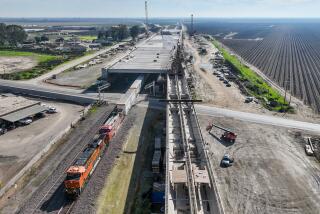Bullet train consultant’s past business ties trouble critics
A transportation expert hired by California bullet train officials to ensure the accuracy of critical ridership forecasts worked for the company that prepared the estimates and maintains a close relationship with one of the firm’s top executives.
The consultant, Frank S. Koppelman, a professor emeritus of civil engineering at Northwestern University, has chaired the California High-Speed Rail Authority’s ridership review panel since December 2010, assessing the projections of Cambridge Systematics Inc., a Massachusetts-based research company.
Authority officials have relied heavily on Koppelman and his five-member panel to bolster the credibility of passenger and revenue forecasts that are crucial for the project. Together, they form the basis for projecting revenue, determining ticket prices and guaranteeing that trains can operate without government subsidies.
The estimates have come under fire from a variety of critics, including UC Berkeley’s acclaimed Institute of Transportation Studies. It asserted almost two years ago that the company’s optimistic projections were too unreliable for policymaking.
Before the authority hired him at $400 an hour, Koppelman worked for Cambridge on two projects advising transit agencies in Chicago and Minneapolis-St. Paul. He also has a long-standing professional and personal relationship with Kimon Proussaloglou, a Cambridge executive vice president in charge of forecasting services.
In an interview, Koppelman said the relationships have not compromised his ability to judge Cambridge’s work. He added that he avoids discussing rail authority business privately with Proussaloglou, who usually speaks on behalf of his firm during meetings with Koppelman’s panel.
“In my mind, there is no conflict of interest,” he said. “I have no doubt in my ability to do a clear-cut job for the authority.”
Koppelman’s panel concluded last fall that shortcomings in Cambridge’s work have been corrected and that the company’s latest ridership projections are reasonable and provide a solid foundation for project planning.
His work for Cambridge was “modest” and ended in 2009, Koppelman said, although he received one payment the year he joined the state review panel because of a late billing. He estimated he was paid $5,000 for one project, but could not recall how much he received on the other.
Koppelman acknowledged a close relationship with Proussaloglou. At Northwestern, he said, he was Proussaloglou’s graduate advisor. Since then, they have co-authored several academic papers and, in November, they made a joint presentation about high-speed rail at a Northwestern transportation symposium.
Socially, Koppelman’s and Proussaloglou’s families get together every few months for lunch or dinner. Koppelman added that he is “very fond” of Proussaloglou’s wife and children.
The association with Proussaloglou, Koppelman said, is like the friendly and professional relationships he has developed over the years with many graduate students at Northwestern. He recalled that when he joined the rail panel, he told Proussaloglou that this was going to be “just like your doctoral dissertation. I’m going to be a real hard-ass about it.”
But critics of the rail project and ethicists who specialize in government questioned Koppelman’s ties to Cambridge and the executive in charge of forecasting.
“Given the critical importance of the ridership numbers and the public issues raised around them, it is troublesome that neither Cambridge Systematics, professor Koppelman nor the authority ever disclosed this publicly. How is this not a conflict of interest?” said Nadia Naik of the Bay Area group Californians Advocating Responsible Rail Design.
Judy Nadler, a former mayor of Santa Clara and senior fellow at the Markkula Center for Applied Ethics at Santa Clara University, said the independence and objectivity of private consultants are critical because elected officials, board members, commissioners and other policymakers make important decisions based on their advice.
“Any time you have these cross-connections that appear to create conflicts of interest, you can get into trouble,” Nadler said. “You need a certain distance that will allow you to do what you are supposed to do — be an impartial gatherer of the facts, assess the facts without bias, and make a recommendation to the governing body. Less than that, you are getting into a danger zone.”
Concerned about preventing conflicts of interest, the state auditor noted in a January report that the high-speed rail authority does not require subcontractors to file statements of economic interests, a public document that lists business relationships and sources of income. The auditor gave Cambridge Systematics as an example.
Before he was hired, Koppelman said he disclosed his associations with Cambridge and Proussaloglou to Roelof van Ark, the rail authority’s chief executive at the time.
“I told him I had this relationship with Kimon Proussaloglou and may have mentioned Cambridge Systematics in a throw-away line,” Koppelman said. “He asked me if it would color my judgment. I assured him it would not.” Van Ark has been unavailable for comment since he left the agency last month.
Koppelman said the rail authority did not ask him to file a statement disclosing income and economic interests, which are usually required of government officials and contractors in decision-making positions.
Cambridge officials and Proussaloglou declined to comment. The firm boasts that dozens of state, federal and international agencies depend on its planning and forecasting models, but it has remained silent about attacks on its ridership figures, except for a sharp retort to the Berkeley report.
Over the years, the bullet train’s passenger estimates have fluctuated from a high of more than 100 million passengers annually for an 800-mile system between San Diego and Sacramento to about 30 million for a 500-mile network linking Anaheim and San Francisco.
In a series of agency reports over the years, Cambridge’s ridership estimates have dropped sharply. The 2008 plan estimated an initial 500-mile system would carry 55 million passengers annually by 2030. In 2009, the number was adjusted to 41 million by 2035. In November, a draft plan put the number in a range as low as 29.6 million by 2040. And the business plan issued last week dropped the middle of the range to 26.4 million and said it could go as low as 20.1 million in 2040.
Koppelman is quoted in the latest report as saying the numbers are “reasonable, possibly even conservative.”
Koppelman acknowledged that it is difficult to predict how many riders the California bullet train would serve because the state lacks a developed conventional rail network. In contrast, France and Japan were operating conventional rail lines at or near capacity before introducing high-speed trains along the same routes. In those cases, planners needed to estimate only how much the new service would increase ridership.
Koppelman said he is among a few consultants in the transportation industry with expertise in travel forecasting. As such, he said, it would be difficult for the high-speed rail authority to hire anyone for his position who does not have past business relationships similar to his.
Kenneth A. Small, professor emeritus of economics at UC Irvine and a member of the ridership review panel, agreed, adding that Koppelman “has shown no coziness toward Cambridge Systematics. He’s objective and fair. He is completely professional about it.”
More to Read
Sign up for Essential California
The most important California stories and recommendations in your inbox every morning.
You may occasionally receive promotional content from the Los Angeles Times.












